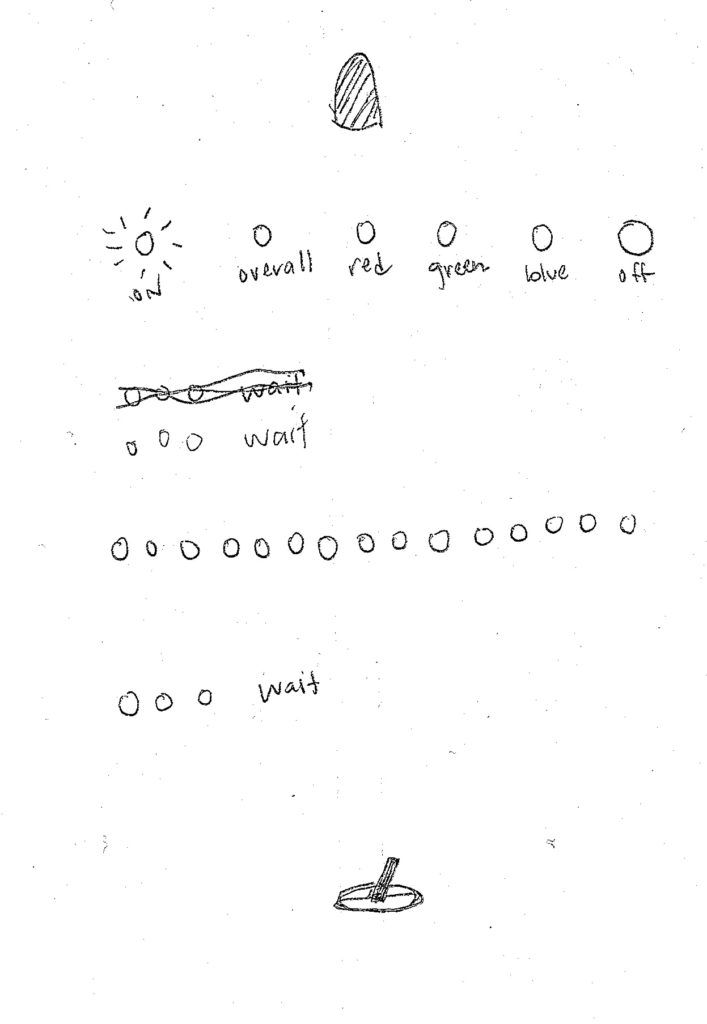Verbose v. Concise
What does it mean to have many functions distributed over many controls as opposed to many functions concentrated into a single control?
The required functions are as follows:
- An on and off control
- When turned on, the previous brightness level is restored.
- Each color channel can be faded from off to full brightness.
- Overall brightness can be faded.
- Brightness is maintained when fade control is released.
- Fade is interruptible by other controllers.
Below describes one controller (as pictured above), and one proposed controller (to be completed shortly, when my millions of switches arrive…)
- CONCISE (one momentary connection): 1 push button that turns an LED on and off, fades each color channel from off to full brightness, and fades overall brightness.
- VERBOSE (many maintained connections): 1 toggle switch that turns an LED on and off, and when turned on, restores the previous brightness level; 255 toggle switches for each channel, (765 total), fade from off to full brightness; another 255 toggle switches fade overall brightness.
In building out the Concise Controller with a single button, the LED functioned not only as the ‘lamp’ itself, but also as a visual indictor for each of the functional conditions. Blinking, fading and solid levels in combination with timed intervals are used to indicate, and then ‘lock in’, changes by the user.

However, how the light is turned off is still a particularly inelegant solution. As an option, it is within the same set of selections as individual color channels, and while the blinking rhythm is different, I anticipate this will be a point of confusion in practice. Alternatively, I’d like to implement an “off” switch by holding down the button for a set period of time and can occur at any point. I tried to get this functional in code, but it needs more work.
At Scale of the Controller v. Transistor
What prompted this idea of verbose and concise controllers was how states are tracked by sensors themselves.
Change is either ‘remembered’ as a constant state as with a toggle switch, or as a change in state as with a push button. (Maintained connection versus momentary connection.) Interestingly, sensors, like push buttons or force sensors, which indicate a change in state from the base condition do not have visual indicators themselves which show the change. (As opposed to a potentiometer or toggle switch in which the state or reading is reliant of the actual physical position — and thus visual indicator.)
How can either of these techniques promote a verbose or concise set of controls?
- Brightness levels and states can either be ‘remembered’ by provisions in the code or are ‘remembered’ by hardware constitution/wiring of the sensor;
- A toggle switch sets one of two physical states, determining an electrical connection, though still coded, as one position is identified as On while the other is identified as Off.
- Similarly, knob and linear potentiometers: The physical connection is maintained at the adjusted position( Rotary knob: requires storage, but differently;
Conversely, a push button denotes a change in state, but isn’t physically changed once it is released; thus it relies more directly on code (physicality at another scale) to toggle between On and Off. A push button is a change, whereas the toggle switch is either on or off.
Similarly analog sensors:
- Force sensors/soft potentiometers output a default reading unless a change/interaction is sensed (depending on wiring);
- Like the push button, for the value to persist, it must be stored in the code.
Early Sketches


There is no transistor in your circuit, so I’m not sure what the transistor vs controller comparison is all about. Can you clarify?
Updated the post with new language. By transistor/controller I meant momentary connections vs maintained connections. It’s likely my description is still a bit fuzzy…I think I’m still trying to get at what the fundamental differences are and how those small things really impact the use and legibility of the sensors.